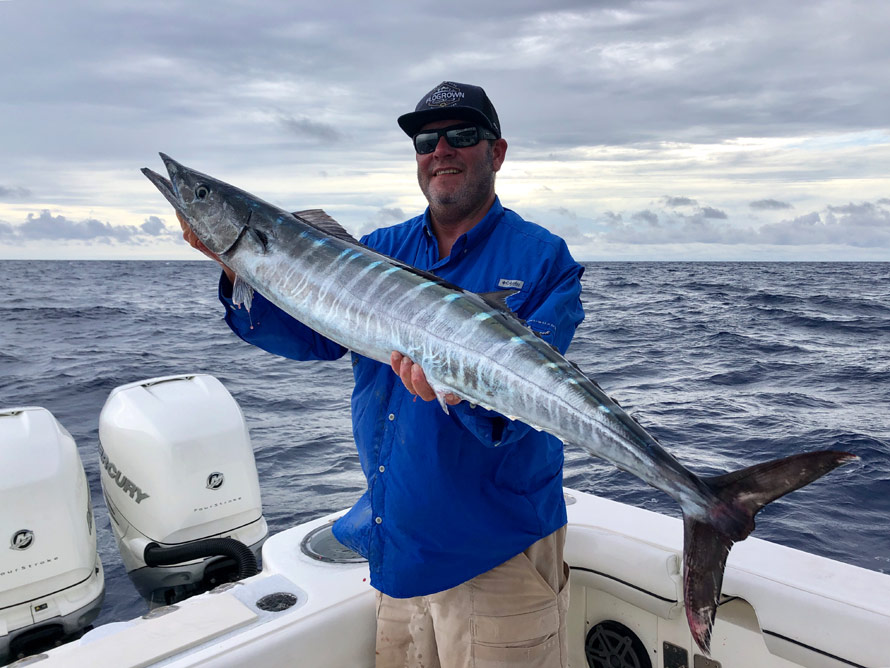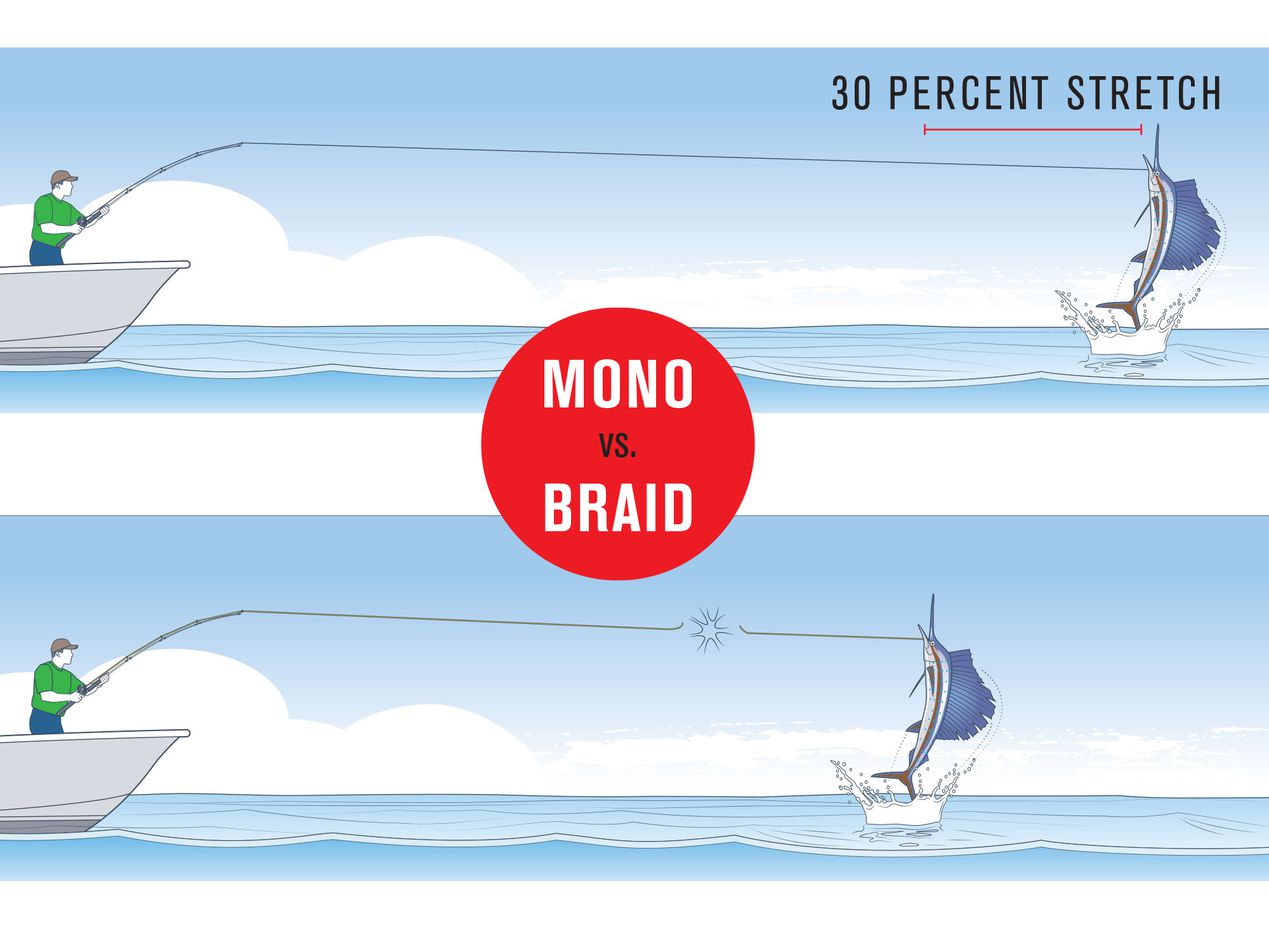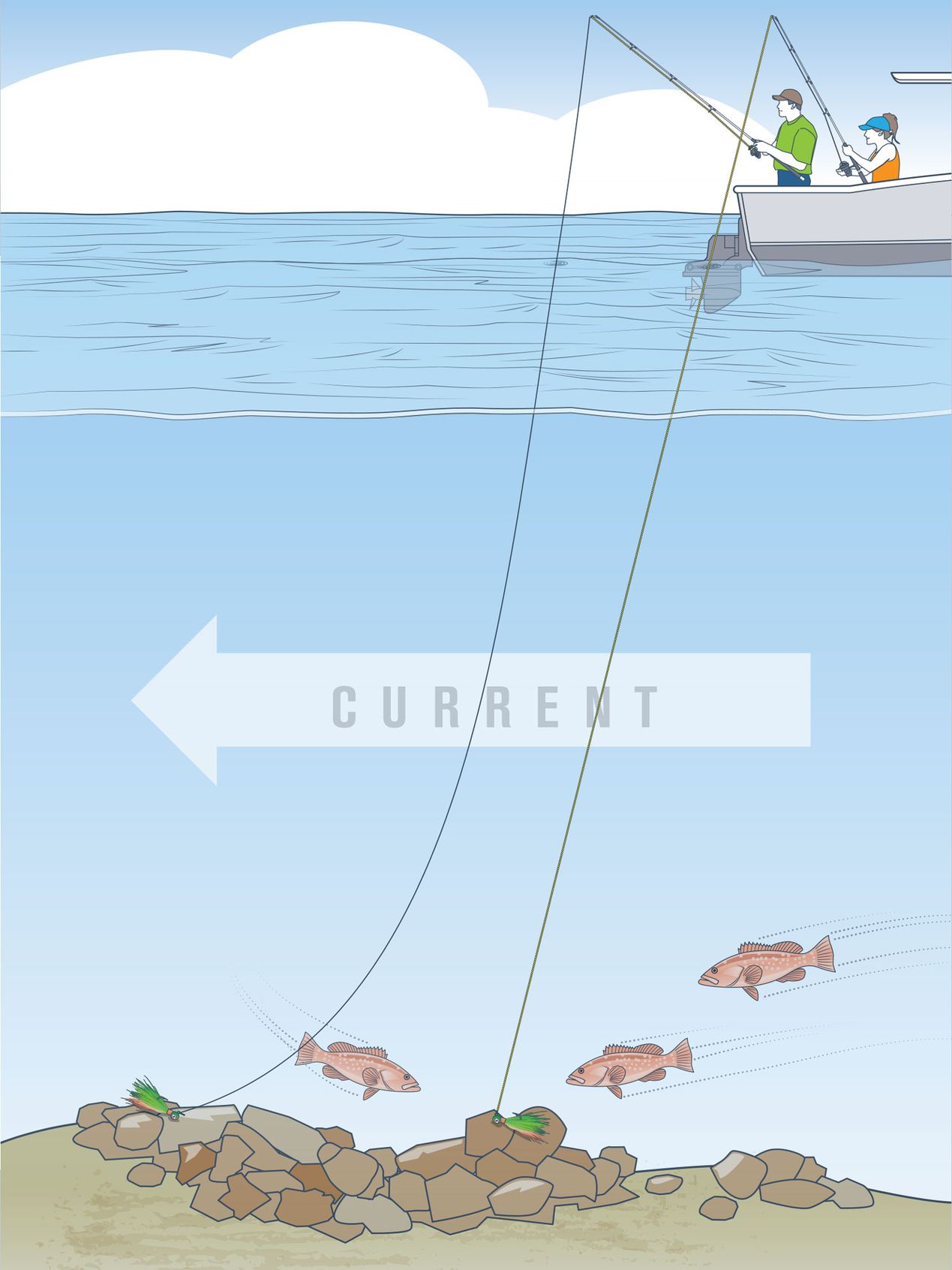Celebrating
|
Monofilament Fishing Line for Saltwater Fishing
|
| Best uses for monofilament fishing line in saltwater. |
| by George Poveromo |
| RETURN TO HOW TO'S MAIN PAGE - CLICK HERE |
 |
| Braided lines dominate bottom fishing. Their smaller diameters enable them to descend rapidly and hold bottom with less weight. Their lack of stretch telegraphs every bump or bite and results in effective hook-sets at considerable depths. Plus, their abrasion resistance is just what the doctor ordered for fishing heavy structure. Capt. Jimmy Gagliardini, a Florida Keys-based bottom fishing specialist, continues to buck this trend by using mono for his wreck and bottom fishing. He reasons that mono is easier to use and more forgiving than braid, making it the best fishing line for saltwater use around offshore structure. Fish are used to seeing braided lines around popular wrecks, so switching to mono yields more bites, he says. Modern monofilament fishing lines offer choices of formulations for specific fishing situations. Ranging from single nylons to co- and multipolymers, different blends enhance durability, casting distance and sensitivity, and reduce stretch. However, the basic advantages of mono fishing line remain. It is easy to handle and safer than braid, key considerations when teaching youngsters to fish. Its inherent stretch is often beneficial. When a hard-charging fish lunges, that stretch acts as a cushion, preventing snapped lines or pulled hooks. With near-zero-stretch braid, fighting drags must be set below normal to acquire similar forgiveness. Monofilament line is often less noticeable to fish and costs less than braid, an incentive to replace it regularly. |
 The stretchiness of mono becomes a safety factor as the line absorbs the shocks of unexpected surges by species such as sailfish. Tim Barker |
| Trade-Offs The same qualities that make braid perfect for many applications create a special challenge in others. The braid vs. mono fishing line debate is not likely to end soon, but mono definitely excels in certain scenarios. In many situations, the inherent stretch in nylon monofilament lines — up to 30 percent before breaking — provides a desired cushion that often prevents breakage. This is especially important with species prone to violent jumps, such as billfish or tarpon. The stretch characteristic of mono fishing line becomes a safety factor as the line absorbs the shocks of unexpected surges by the fish. Meanwhile, braid, which lacks that stretch, may break with a sudden shock. Monofilament fishing lines stretch as much as 30 percent. In some cases, it’s an advantage, but in others it’s a disadvantage. When trying to get a bait to the bottom in deep water, the larger-diameter mono generates more resistance, resulting in slower sink rates. In addition, setting the hook is more difficult in some situations due to stretch. Many mono lines are known to test above their rated breaking strength, a consideration when seeking records. According to Ben Miller at Sufix, the advertised breaking strength of most monofilament fishing lines is determined by knot strength, the point at which the test knot, usually a Palomar, breaks. Rarely is the breaking strength determined by tensile strength, the point at which breakage occurs in a standardized pull test. Tensile strength is generally higher than the knot strength. |
| Not Your Dad's Mono All this means that more thought should go into deciding the best monofilament fishing line for saltwater. There are premium versions for general all-around toughness, and other formulations that excel in niche situations. For my offshore trolling, when live-baiting pelagics, I want a strong, abrasion-resistant mono. I'm not interested in ultralong casts, nor am I gunning for world records. If that line tests slightly above its rated breaking strength, so be it. I want to know it will hold up in a tough, drawn-out fight. My choice of offshore monofilament? Sufix Superior. Also in the premium category are Berkley’s ProSpec and ProSpec Chrome. According to Pure Fishing’s Clay Norris, big-game anglers seek stronger lines with smaller diameters for more line capacity and a high abrasion resistance. Again, there’s little concern with these lines over-testing, but there is a lot of emphasis on them weathering the stress of a long fight with a powerful fish. |
| Lighten Up Suppleness is also a consideration, especially in lower strengths, like 20-pound-test, when live-baiting for sailfish, white marlin and other pelagics. “ProSpec and ProSpec Chrome were developed especially for the big-game angler, and those who demand an ultra-strong and durable line,” Norris says. “ProSpec Chrome is slightly stronger than ProSpec, but standard ProSpec is a bit more supple and easier to handle.” When casting distance and accuracy are crucial, softer formulations result in minimal resistance from the spool and lay, reducing drag and its influence on the action of baits or lures. The diameters of casting-oriented lines are ¬generally smaller than premium lines of the same breaking strengths, allowing for enhanced sensitivity, stealthier presentations, and even less resistance. Yet, while a line excels in one area, it may be average in another. The abrasion resistance and durability of casting-oriented lines, for instance, may not match those of less-supple premium lines. “Among Berkley’s top casting-oriented saltwater lines, Trilene Sensation has the smallest diameter per breaking strength,” Norris says. “It’s ideal for distance and accuracy, and the small diameters increase sensitivity. There’s also the option of stepping up in strength and still keeping an ¬easily manageable diameter. Stretch is less too, so hook-set efficiency increases.” “The goal with monofilament lines formulated for enhanced casting is to find that right blend of softness, sensitivity, abrasion resistance, durability and minimal memory,” says Sufix’s Ben Smith. “Sufix’s Tritanium Plus is a copolymer long-casting line with better abrasion resistance than some of our other lines, and with higher sensitivity. So it’s also a good choice for those who prefer monofilament for bottomfishing or jigging around structure.” For record seeking, a line must test right at the rated breaking strength to qualify for a line-class record. Performance lines may over-test. If you’re into line-class and club world records, there are certain lines designed specifically for tournaments and record seekers that break right at their -advertised breaking strengths. The Tournament label by Ande Monofilament is among the most popular in this category because it conforms to the IGFA’s stringent line test standards. |
 |
| GET IT STRAIGHT When bottom fishing directly under the boat, keeping the line vertical becomes critical. With the smaller diameter-to-break-strength ratio, braids are less affected by current than monofilament lines, which helps to maintain a more direct connection with the bait or lure. Tim Barker |
| WHEN TO CHANGE MONO LINES Monofilament fishing lines let you know when they need to be replaced. Mono line has a slick coating, referred to as a spin finish. When mono loses its brilliance, it’s time to strip off the dull portion or replace the entire line. And if wear shows after a strenuous fight, change the line. It’s best to replace 8- to 20-pound mono line after catching several school fish, or a sizable pelagic, like a sailfish or a 40- to 60-pound tuna, or after prolonged casting over multiple trips. With spin tackle, keep spare spools with fresh line in case you need to change it out on the water. Heavier lines (30-, 50- and 80-pound) should be replaced after fighting a tougher opponent, like a bigger tuna, a shark or a blue marlin. If you fish often and smaller fish are the norm, change the line at least a couple of times a season. Remember that humidity and sunlight have accumulative and damaging effects on mono lines as well. |
| Voice From the Past Despite advances in mono fishing line, I remember a bit of sound advice that still rings true today. “Think of monofilament line as a race car tire,” an accomplished angler and stock-car fan told me back in the late 1970s. “When those tires are half to three-quarters worn, they still work, but with half the traction and grip of new ones, so speed falls way off. Want to win? Keep new ones on the car. Monofilament line is no different. Brand new, it’s at its prime, but catch some big fish on it and its reliability diminishes. It may be OK for catching small fish, but it’s likely to fail on the next big fish.” Though he was referring to lines in the 6-pound-class category, I got his drift and I’ve applied that philosophy to every line class ever since. I truly believe his wisdom helped account for many of the quality fish I’ve bested over the years. |
| RETURN TO HOW TO'S MAIN PAGE - CLICK HERE |

